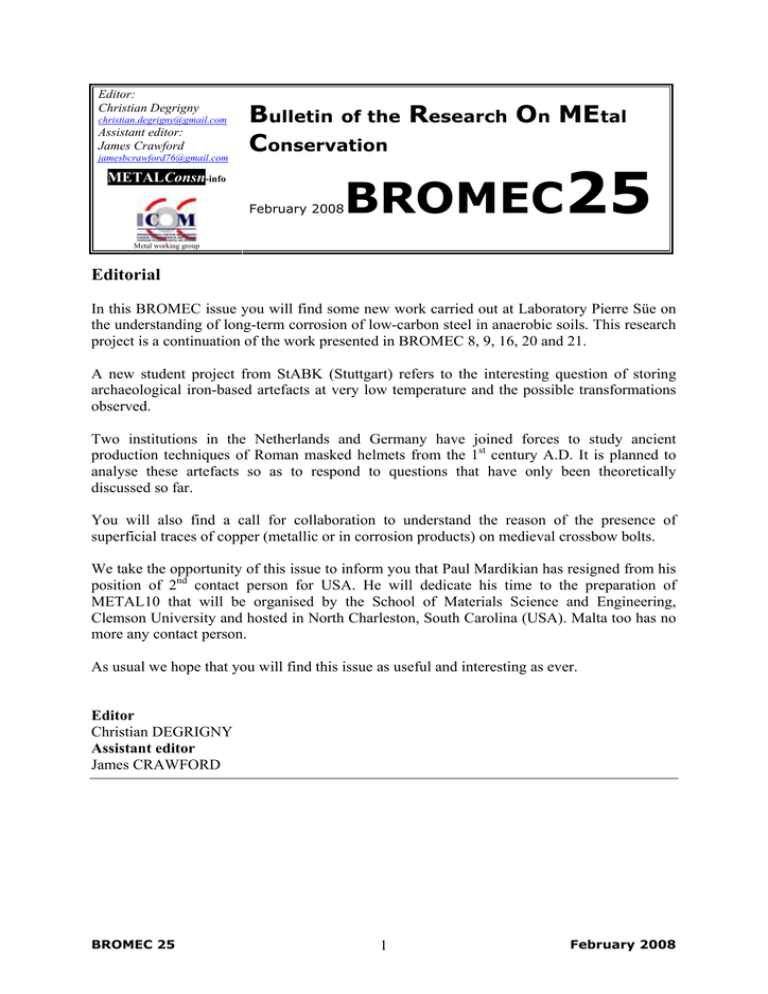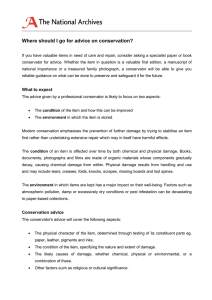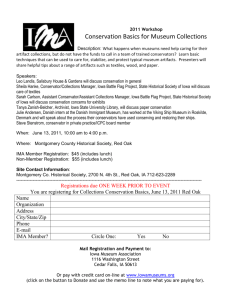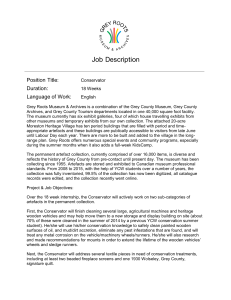25 BROMEC B R
advertisement

Editor: Christian Degrigny christian.degrigny@gmail.com Assistant editor: James Crawford jamesbcrawford76@gmail.com METALConsn-info Bulletin of the Research On MEtal Conservation BROMEC25 February 2008 Metal working group Editorial In this BROMEC issue you will find some new work carried out at Laboratory Pierre Süe on the understanding of long-term corrosion of low-carbon steel in anaerobic soils. This research project is a continuation of the work presented in BROMEC 8, 9, 16, 20 and 21. A new student project from StABK (Stuttgart) refers to the interesting question of storing archaeological iron-based artefacts at very low temperature and the possible transformations observed. Two institutions in the Netherlands and Germany have joined forces to study ancient production techniques of Roman masked helmets from the 1st century A.D. It is planned to analyse these artefacts so as to respond to questions that have only been theoretically discussed so far. You will also find a call for collaboration to understand the reason of the presence of superficial traces of copper (metallic or in corrosion products) on medieval crossbow bolts. We take the opportunity of this issue to inform you that Paul Mardikian has resigned from his position of 2nd contact person for USA. He will dedicate his time to the preparation of METAL10 that will be organised by the School of Materials Science and Engineering, Clemson University and hosted in North Charleston, South Carolina (USA). Malta too has no more any contact person. As usual we hope that you will find this issue as useful and interesting as ever. Editor Christian DEGRIGNY Assistant editor James CRAWFORD BROMEC 25 1 February 2008 Contents Page New research project Long-term corrosion behaviour of low-carbon steel in anaerobic soils 3 Keep cool? Deep freeze storage of archaeological iron 4 / Ancient production techniques of Roman masked helmets from the 1st century A.D. 5 Call for collaboration A metal can hide another one... BROMEC 25 6 2 February 2008 New research projects Long-term corrosion behaviour of low carbon steel in anaerobic soils (LPS/Andra/IRA) This PhD research project relates to the in-situ conservation of buried objects and the longterm storage of radioactive waste in France. In both cases, the understanding of corrosion mechanisms of iron-based alloys in the long-term and in anaerobic conditions allows understanding their behaviour in buried environments. This should be used to monitor their condition state based on the assessment of their corrosion rates. In this context, 15 artefacts from two anaerobic reference sites were analysed. To propose a corrosion mechanism for iron-based alloys in anaerobic conditions, it is first required to characterise the corrosion system (metal / corrosion products / medium). To do this a thorough study of burial conditions on these archaeological sites (pH, Eh, water composition) as well as the corrosion forms observed on cross-sections of iron artefacts is carried out. The microbeam techniques used are Raman spectroscopy, X-ray microdiffraction, scanning electron microscopy and dispersive selection microanalysis. In parallel, in order to localise the reactions sites in the corrosion layers, the objects are immersed in deuterium (2H or D) marked medium. The first results have shown that the burial medium for the two archaeological sites is essentially constituted of calcium carbonates. Analyses on freshly excavated artefacts reveal a corrosion layer mostly constituted of siderite (FeCO3) and an iron hydroxycarbonate Fe2(OH)2CO3 with some magnetite layers (Fe3O4) and sulphur containing layers (<18% mass). Electrochemical studies of artefacts immersed in deuterium marked medium will be used to monitor the progress of the corrosion. The identification of precipitation sites of phases rich in deuterium will permit the proposition of corrosion mechanisms in anaerobic conditions. Contacts: Mandana Saheb & Philippe Dillmann (LPS / Andra), Delphine Neff (LPS) Funding: Andra and the French National Agency for Research (ANR program ARCOR) BROMEC 25 3 February 2008 New research projects Keep cool? Deep freeze storage of archaeological iron (StABK) To slow down or stop corrosion, iron finds have been deep-frozen in Baden-Württemberg since the 1970s. There are now 16 (!) tonnes in the freezing chamber of the newly built conservation laboratory of the State Monument Protection Office (Landesdenkmalamt). Despite good results in the short-term, iron finds do not seem to be stable over decades. Experience with iron in Antarctic huts of polar researchers also raise questions on the corrosion stability of iron below the freezing point of water. To test the corrosivity of deep-freeze storage at -20°C, test samples of a mixture of iron powder and ferrous chloride-tetrahydrate (FeCl2·4H2O; see Watkinson and Lewis in Metal04 for the method) were prepared. Above 19%RH, they form akaganéite in the air at room temperature. The mixture mimics the condition of excavated iron objects when the solution in the pores containing chloride and ferrous ions dries out. Thickett devised a method to estimate the akaganéite content in the mixture from the intensity of the specific FTIR band at 852 cm-1 [1]. Guggenheimer (VDR Beiträge, forthcoming) used the method to test the efficiency of storing iron in sealed plastic bags with oxygen and humidity scavengers (Mitsubishi RP-A System). In cooperation with the Institute of Inorganic Chemistry, University of Tübingen, the study programme ‘Objects Conservation’ from the State Academy of Art and Design Stuttgart (StABK) now stored test mixtures in a deep-freezer to analyze how long it takes to form akaganéite. Samples stored for comparison at room temperatures and not too dry changed their colour to a typical rust-brown after few days; akaganéite could be detected by FTIR spectra. Although a slight colour change to light brown was also observed quite soon on samples from the freezer, there are no significant changes in the IR spectra even after half a year. Akaganéite could definitely not be observed. Further analyses will be done in the coming years to assess the long-term efficiency of the (energy consuming and expensive) deep-freeze storage. During the project objects already deep-frozen for years will also be surveyed to learn more about their state of preservation and occurring damage. 1. Thickett, D. 2004, Analysis of iron corrosion products with Fourier Transform Infra-red and Raman spectroscopies, Infrared User Group Meeting 6, Florence (Italy). To obtain a copy please contact D. Thickett (David.Thickett@english-heritage.org.uk) Contact: Charlotte Kuhn (StABK) Funding: no external funding BROMEC 25 4 February 2008 New research projects Ancient production techniques of Roman masked helmets from the 1st century AD (MHV-MK / RLB) / This joint German-Dutch archaeological research project (2006-2007) deals with antique production techniques of Roman masked helmets (cavalier helmets) of particular cultural and historical value, such as helmets from Nijmegen, Museum Het Valkof, Xanten, Rheinisches LandesMuseum Bonn and Regionalmuseum Xanten. These metallic iron masked helmets were part of Roman fighting and parade armament and constitute rare and exciting finds of their time. They consist of a helmet comprising a mask depicting a human face. It was common practice to wear them during parades or show fights, but also in real combat. The metallic face served not only as protection; it was also intended to alienate and to frighten the enemy with its metallic glance (covered with silver) and its fixed gaze. In addition to decorations of very thin sheet metal, these extraordinary and singular helmets had spectacular helmet decorations made of genuine horse hair ("perukes"). In 1999 and 2004, Rheinisches LandesMuseum Bonn already successfully conducted two conservation-research projects concerning Roman masked helmets [1]. Due to the special skills and experiences gained, the Museum Het Valkof at Nijmegen initiated a research project between the two institutions. The objective was to fundamentally investigate the masked helmet types of 1st century AD from Nijmegen and Xanten, which had not been sufficiently investigated so far. We intend to analyse and determine production techniques of masked helmets and their workflows as well as the required material for the first time. Furthermore questions arise about the place of production of such helmets. Were they imports or local productions? How far were the techniques developed and can we speak of an "industrialised" production? How much time did it take to make a masked helmet and how expensive were the associated costs? How did the organisation of production steps function? How robust were these helmets and could they offer protection to the rider, not only in case of parades and show fights, but also in real combat? In addition to these questions we found and analysed a Roman glue (a mixture made from bitumen, tree tar (may be from a pine) and tallow) that was used to mount thin silver sheets on iron helmets. It is the first time that such a glue is observed. We hope through this project to respond practically to questions that have only been discussed theoretically so far. 1 Meijers, R and Willer, F. Hinter der silbernen Maske / Achter het zilveren masker, eds. Museum Het Valkof in Nijmegen and the Rheinisches LandesMuseum Bonn / Landschaftverband Rheinland (Rhineland), 2007, 111p. Can be ordered at the Museum Het Valkof in Nijmegen or at the Rheinisches LandesMuseum Bonn (15€) Contacts: Ronny Meijers (MHV-MK) and Frank Willer (RLB) Funding: no external funding BROMEC 25 5 February 2008 Call for collaboration A metal can hide another one… (SADY) In 2007 we conserved a group of crossbow bolts recovered from the Château of Chevreuse. On a large number of these bolts remains of copper-based alloys (metallic or in corrosion products) were found. The remnants were in the internal and/or on the external surface of the bolts. We would be grateful to any colleague who has been confronted with the same observations or has some literature on the subject. Colleagues with ideas on the use or function of copper-based alloys on such bolts are invited to contact us. Contact: Silvia Païn (SADY) BROMEC 25 6 February 2008 General information Websites - ARTECH network: http://server.icvbc.cnr.it/progetti_futuri/progetto_artech.htm. Network facilitating the access of conservation professionals to different investigation techniques of Cultural Heritage artefacts - BIGSTUFF (Care of Large Technology Objects) 2004: http://www.awm.gov.au/events/conference/bigstuff/index.asp - CAMEO: website containing chemical, physical, visual, and analytical information on over 10,000 historic and contemporary materials used in the conservation, preservation, and production of artistic, architectural, and archaeological materials http://www.mfa.org/_cameo/frontend/ - Cost Action G8: Non-destructive analysis and testing of museum objects. http://srs.dl.ac.uk/arch/cost-g8. Abstracts and booklets from previous workshops can be downloaded as well as announcements of past activities (Short Term Scientific Missions deadlines, training schools…). - Cost Action G7: Artwork conservation by laser http://alpha1.infim.ro/cost - Cost Action D42: ENVIART (Chemical Interactions between Cultural Artefacts and Indoor Environment): www.enviart.org. You have to register (free access) to get access to all information. - e-Preservation Science: http://www.e-preservationscience.org. Online publication of papers in conservation science. - European Cultural Heritage Network: http://www.echn.net/. European network of professionals interested in the conservation of Cultural Heritage. - ICOMAM: International Committee of Museums and Collections of Arms and Military History: http://www.klm-mra.be/icomam - IR and Raman for cultural heritage: http://www.irug.org/default.asp - LabS-TECH network http://www.chm.unipg.it/chimgen/LabS-TECH.html - Laboratoire Pierre Sue: LPS PhD thesis related to the alteration of archaeological artefacts can be downloaded from http://www-drecam.cea.fr/lps/ (in French) and go to “Archéomateriaux et prévision de l’altération.” - METALConsn-info homepage: http://rsc.anu.edu.au/~hallam/METALConsn-info.html - M2ADL - Microchemistry and Microscopy Art Diagnostic Laboratory is now available at the following website: http://www.tecore.unibo.it/html/Lab_Microscopia/M2ADL/ - New York Conservation Foundation website: http://www.nycf.org/ BROMEC 25 7 February 2008 - PROMET website: http://www.promet.org.gr - RESTAURACION METAL SUR AMERICA: www.restauraciondemetales.cl - TEL (PhDs on line): http://tel.ccsd.cnrs.fr/ - Working Group Metals ICOM -Committee for Conservation http://icom-cc.icom.museum/WG/Metals/ - Online publications of Surface Engineering Journal. Issue addressing specifically to Metal issues: Surface Modification Issues in Art, Volume 17, Issue 3, June 2001. Can be downloaded from:(http://www.ingentaconnect.com/content/maney/se/2001/00000017/00000003;jsessionid =1xpmlw91522a3.victoria) - ANDRA (Agence Nationale pour la Gestion des Déchets RadioActifs) http://www.andra.fr/interne.php3?publi=publication&id_rubrique=82&p=produit&id=5. The following documents can be ordered for free from this website : Analogues archéologiques et corrosion (in French only) and Prediction of Long Term Corrosion Behaviour in Nuclear Waste Systems (in English). Future seminars and conference - Holding it all together; ancient and modern approaches to joining, repair and consolidation (21-22 February 2008, London, UK) organised by the British Museum. For more information contact Janet Ambers: science@thebritishmuseum.ac.uk - MetalEspaña ’08 Conference on Conservation and Restoration of Metallic Cultural Heritage (10-13 April 2008, Madrid, ES) organized by the National Center for Metallurgical Research (CENIM), CSIC and Autonomous University of Madrid (UAM). For more information, contact congreso.metalespana08@cenim.csic.es or visit www.cenim.csic.es/metalespana08 - 8th Indoor Air Quality (IAQ2008) meeting (17-19 April 2008, Vienna, AT) organised by the Kunsthistorisches Museum. For more information visit the following website: www.khm.at/IAQ2008 - Art2008, 9th International Conference (25-30 May 2008, Jerusalem, Israel) on the nondestructive testing, microanalysis and preservation in the conservation of cultural and environmental heritage, organised by the Israel National Society for NFT. For more information visit the following website: www.isas.co.il/art2008 - Ancient mining in Turkey and the Eastern Mediterranean - AMITEM (15-21 June 2008, Ankara, Turkey) organised by the Institute of Archaeometallurgical Studies, Bogazici University, Istanbul (Turkey), the Deutsches Bergbau – Museum Bochum (D), the Institute of Archaeology, London (UK) and the Atilim University, Ankara (Turkey). For more information visit the following website: http://amitem.atilim.edu.tr - 3rd Latin-American Congress on metal conservation (10-16 November 2008, Mexico City, Mexico) will be organised and hosted at ENCRYM (Escuela Nacional de Conservación, Restauración y Museografía). For more information please contact Jannen Contreras (jannencontreras@yahoo.com.mx) or Maria Pilar Tapia Lopez (mariapilartapialopez@yahoo.com.mx). - The 8th European Conference on Research for Protection, Conservation and Enhancement of Cultural Heritage (11-13 November 2008, Ljubljana, Slovenia) organised BROMEC 25 8 February 2008 by the National and University Library of Slovenia. For more information visit the conference site www.chresp.eu - CSA 2008: mobile analytics for heritage conservation (17-18 November 2008, Somerset, USA) organised by John Scott (NYCF) and David Thickett (English Heritage). For more information visit the following website: http://www.eas.org/pdf/Update.pdf (search on heritage and preservation) - the 17th International Bronze Congress (24-28 May 2009, Athens, Gr) will be sponsored and organised by the American School of Classical Studies at Athens, the Center for the Ancient Mediterranean of Columbia University, and the University of Athens. For more information please contact Alessandra Giumlia-Mair (giumlia@yahoo.it). Abbreviations and acronyms IRA: Institut de recherche sur les archéomatériaux LPS: Laboratoire Pierre Süe MHV-MK: Museum Het Valkhof, Museum Kamstraat NYCF: New York Conservation Foundation RLB: Rheinisches LandesMuseum Bonn SADY: Service archéologique départemental des Yvelines StABK: Staatliche Akademie der Bildenden Kuenste Stuttgart Contacts Charlotte Kuhn / StABK (charlotte@charlotte-kuhn.de) Ronny Meijers / MHV-MK (r.meijers@museumhetvalkhof.nl) Frank Miller / RLB (frank.willer@lvr.de) Silvia Païn / SADY (spain@cg78.fr) Mandana Saheb / LPS/Andra (mandana.saheb@cea.fr) National contact persons for the homepage METALConsn-info Argentina: Blanca Rosales, researcher, CIDEPINT, La Plata Australia: David Hallam, senior conservator of objects at the National Museum of Australia, Canberra Belgium: Annemie Adriaens, researcher and lecturer, head of the group “Electrochemistry and Surface Analysis”, Ghent University, Ghent and Gilberte Dewanckel, conservator at IRPA (Institut Royal du patrimoine artistique), Bruxelles Bulgaria: Petia Penkova, conservator, National Academy of Arts, Department of conservation-restoration, Sofia Canada: Judy Logan, conservator (retired), Ottawa Chile: Johanna Theile, conservator and lecturer, Facultad de Arte - Universidad de Chile Las Encinas, Santiago de Chile Croatia: Goran Budija, conservator, Museum of Arts and Crafts, Zagreb Czech Republic: Dusan Perlik, conservator, Museum of Central Bohemia, Roztoky Denmark: Karen Stemann Petersen, conservator, The National Museum of Denmark, Copenhagen Egypt : Wafaa Anwar Mohamed, conservator, Giza Finland : Eero Ehanti, conservator, Maritime Museum of Finland, Helsinki France: Marie-Anne Loeper-Attia, conservator and assistant-lecturer at the Conservation Department, Institut National du Patrimoine, St Denis, Paris and Christian Degrigny, conservation scientist, Château de Germolles, Germolles BROMEC 25 9 February 2008 Germany: Gerhard Eggert, head, study program “Object Conservation”, Staatliche Akademie der Bildenden Künste, Stuttgart Greece: Vasilike Argyropoulos, assistant professor, Department of Conservation of Works of Art, Technological Educational Institution, Athens Hungary: Balazs Lencz, senior conservator, Conservation Department, Hungarian National Museum, Budapest Italy: Paola Letardi, scientist, Istituto per la corrosione marina dei metalli (ICMM), Genova The Netherlands: Ineke Joosten, conservation scientist, The Netherlands Institute of Cultural Heritage, Amsterdam Morocco: Hind Hammouch, scientist, Laboratory of Electrochemistry, Corrosion and Environment, Faculty of Science, Université Ibn Tofail, Kenitra Norway: Douwtje Van der Meulen, conservator, Conservation Department, University of Oslo, Oslo Portugal: Isabel Tissot, conservator, Portuguese conservation-restoration Institute, Lisbon Romania: Dorin Barbu, conservator, Brukenthal Museum, Sibiu Russian Federation: Andrey Chulin, conservator, the State Hermitage Museum, St Petersburg South Africa: Jaco Boshoff, maritime archaeologist, Iziko Museums of Cape Town, South Africa Spain: Emilio Cano, conservator, National Centre for Metallurgical Research (CENIM), Spanish Council for Scientific Research (CSIC), Madrid Sweden: Helena Strandberg, conservator and conservation scientist, freelancer, Göteborg Switzerland: Valentin Boissonnas, conservator and lecturer, Haute école d’arts appliqués Arc, La Chaux-de-Fonds United Kingdom: Catia Viegas Wesolowska, conservator, Victoria & Albert Museum, Londres & Mark Dowsett, physicist, Warwick University, Coventry USA: John Scott, New York Conservation Foundation, New York BROMEC 25 10 February 2008






